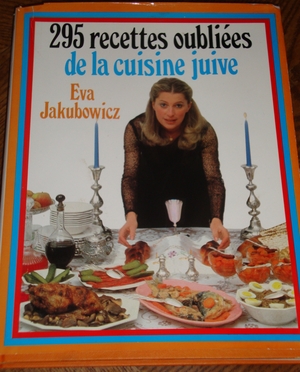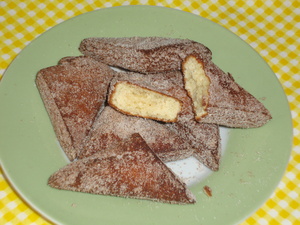A new cookbook of Jewish cuisine produces a semi-failed experiment


A treasure from the Re-Use Center: a French cookbook of Jewish recipes.
Several weeks ago, while trolling through thrift shops with Tom (a beloved pastime … I excel at finding priceless tidbits, from clothes to dishes), we meandered through the Re-Use Center on Industrial. He went in search of our goal, a floor lamp to brighten my living room, while I got lost in perusing the books. Lots of old bestsellers, a couple of Oprah selections (and the seal of approval from Oprah is a guarantee that I won't either own or read the book), an assortment of Star Trek novels … nothing among the extensive offerings was drawing my attention until I found the foreign language shelf.
A few meager books were looking forlorn there, but among them I found two absolutely stellar prizes: a pocket-sized copy of selections from Ethics of the Fathers, a Jewish classic, with phrases of wisdom written in Hebrew, English, German and French; and the French cookbook pictured above, whose title translates to 295 Forgotten Recipes from Jewish Cuisine.
Now this was an exceptional find! Not only do I have a tremendous affinity for Jewish foods, but I was once fluent in French and often bemoan not having any opportunity to refresh my skills. The order of nuns who taught me for 13 years - The Religious of the Sacred Heart of Jesus - was founded in France by St. Madeleine Sophie Barat; everyone who attends a Sacred Heart school throughout the world inevitably learns French, and I studied it from second grade all the way through high school and even a bit in college. So you can only imagine my thrill in finding not just any old cookbook (and I've got nearly 100 of them, so it takes a lot to impress me), but a cookbook with recipes for classic Jewish foods, and one written entirely in French for me to practice with!
So Purim was the day to delve into the translation and attempt to make something from my French cookbook. And what better option than "Pourim Kiheleh - Gâteau de Pourim," which is a Purim Cake? Except, as I read over the recipe (and got the general gist of it, though I admit I had to look up the word “cannelle,” which means “cinnamon”), it was clear that this was not a cake recipe … the final instruction is to “cut the pastry into small triangles that you can fry in very hot oil.” Oh, well, let's try it anyway even if it isn't really a cake! I hadn't fried anything since making the ricotta doughnuts for Chanukkah, so my arteries were ready for the assault.
The first thing I did was take out the handy-dandy food scale that Jeremy had very thoughtfully given me for either my birthday or Christmas several years ago (they're both in December, so I tend to lose track of which event I receive which gifts for), and started to measure ingredients in grams and then place them into measuring cups to convert to conventional units. Then I placed the flour into a large mixing bowl, proofed the yeast and exchanged granulated sugar for the confectioners' sugar that I seemed to have run out of and not replenished. I put everything together … and instead of finding a lovely dough, the mixture seemed to be the consistency of a sugar cookie dough that wasn't holding together very well. I added an egg for binding, and that helped enormously; I was then able to knead the dough, which seemed to be coming together perfectly. I covered it with a bowl, let it rest for an hour … and it hadn't risen a bit.
Well, the kitchen counter was admittedly a bit chilly, and yeast thrives in warmth; and while I had cut the butter in half (thank goodness, because otherwise I'd have merely had crumbly sugar cookie dough swimming in grease, before adding the egg to bind it all together), fat impedes the development of gluten and perhaps I should have used still less. But the dough will puff up beautifully when it hits that hot oil, right? Wrong.
I cut the dough into triangles, per the instructions, and I fried one up until it was a beautiful golden color. It didn't puff, but perhaps that's what was intended? (The cookbook offers almost no photos, and this recipe was not one of the chosen few to be illustrated.) I cut it open to see how it looked inside, only to find my gorgeous golden crust surrounding uncooked goo.
For the next batch, I fried a few pastries until they were a deep, dark brown - not quite burnt, but pretty close to it. At least the pastries were cooked throughout, though they still weren't becoming puffed and light and flaky. But cinnamon sugar is not only good for the soul, it's good for hiding problems in sweet foods; and so once the hot pastries found themselves immersed in that coating, their many sins - being overcooked and leaden, for starters - were sufficiently disguised that they were at least edible. And the house did smell amazing, with aromatherapy being an added bonus of cooking and baking.
Jeremy thought the pastries were “Okay;” but he not only didn't devour the entire plateful, as one would expect a 19-year-old male to do, he didn't even eat a second one. (Of course, he was devouring hamantaschen at the time that I forced the pastry upon him, so who needed anything more?) Tom tried one when he came over later that evening and actually told me they were good despite their having gotten cold as they sat untouched on the kitchen counter throughout the day. (Ah, the things we do and say for those we love!)
We discussed the merits and deficiencies of the recipe and of its final product, not to mention that sometimes a recipe is simply written poorly, ingredients are left out, techniques are badly explained, and it's not always necessarily the cook's fault if things don't turn out properly. I hope this offers encouragement to any fledgling cooks - even those of us who are devoted to the art and who might be considered "experts" don't always find success at the end of the process!
Tom and I also determined that this could at least be the start of a new recipe - perhaps I could add more yeast or baking soda or beer to encourage the dough to rise, or I could roll it out very flat and fry the pastries as though they were tortilla chips. The basic recipe seems to have a great deal of potential for a future kitchen adventure … stay tuned!

The Original Recipe: Pourim Kiheleh - Gâteau de Pourim
Utensiles:
1 terrine
1 poêle
Ingrédients:
250 g de farine
levure de boulanger
lait
cannelle en poudre
sel
sucre en poudre
125 g de beurre
Verser dans une terrine 250 g de farine, en ménageant un puits au milieu. Verser dans le puits une noix de levure fraîche délayée dans un peu de lait tiède, deux pincées de cannelle, une pincée de sel, un demi-verre de sucre en poudre, 125 g de beurre fondu. Bien mélanger le tout. Etendre la pâte en lui donnant l'épaisseur d'une pièce de monnaie. Couvrir la pâte d'un torchon et laisser lever pendant deux heures. Ensuite, couper la pâte en petits triangles que vous ferez frire dans de l'huile très chaude.
My Version: Fried Purim Pastries
2 cups flour
1/2 cup + pinch of sugar
1/4 cup warm vanilla soy milk
1 packet quick-rise yeast
1 beaten egg
1/4 cup butter, melted
1/4 teaspoon cinnamon
1 teaspoon salt
oil, for deep frying
cinnamon sugar, to coat pastries
Place the flour into a large mixing bowl; set aside.
Add the pinch of sugar to the soy milk, then add the yeast; let the yeast proof for 5 minutes. Add the yeast mixture to the flour along with the egg, butter, cinnamon, salt and 1/2 cup sugar; mix well, then knead on a lightly floured countertop for 5 minutes until smooth and elastic.
Roll the dough out on a lightly floured countertop until it is 1/2” thick. Cover with a large mixing bowl and let rest for 45 minutes.
Cut the dough into 4 columns by 3 rows, then make diagonal cuts to form triangles of dough. Heat oil in a deep-sided frying pan and place 6 triangles into the oil to fry for 1 minute until well-browned. Remove from oil, dry on paper towels, and coat with cinnamon sugar. Serve warm.
Mary Bilyeu has won or placed in more than 60 cooking contests and writes about her adventures as she tries to win prizes, feeds hungry teenagers and other loved ones, and generally just has fun in the kitchen. The phrase "You Should Only Be Happy" (written in Hebrew on the stone pictured next to the blog's title) comes from Deuteronomy 16:15 and is a wish for all her readers as they cook along with her ... may you always be happy here! You can contact Mary at yentamary@gmail.com. And look for an assortment of musings about a variety of topics on her blog: youshouldonlybehappy.blogspot.com.

